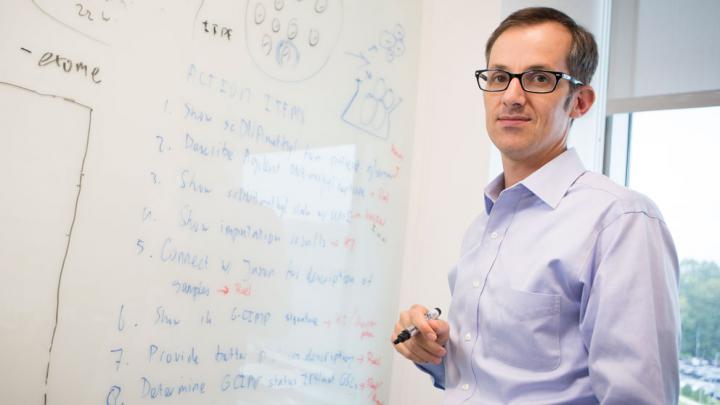The Glioma Longitudinal Analysis (GLASS) Consortium finds longitudinal molecular trajectories of diffuse glioma in adults

Credit: JAX photo byTiffany Laufer.
Until relatively recently, cancer was viewed as a single disease with sub-types based on where in the body it arose. The advent of detailed molecular analysis has shown that the situation is far more complicated, however, and that there can be many sub-clonal cell populations even within a single tumor. And therein lies a significant problem for effective therapy: eradicating one type of cancer cell may leave another unaffected, and it may actually confer a competitive advantage to it.
The most common malignant brain tumor in adults, diffuse glioma, is also one of the most difficult cancers to treat. It invariably relapses despite surgical, radiotherapeutic and/or chemotherapeutic interventions. But while the initial molecular characteristics have been well described in gliomas, their subsequent evolution under treatment stress remains unknown. To address the problem, an international community of clinicians and researchers established the Glioma Longitudinal Analysis (GLASS) Consortium, which has begun investigating the dynamics of molecular changes in gliomas over time. Their findings to this point, “Longitudinal molecular trajectories of diffuse glioma in adults,” are now published in Nature, and they point to highly variable and patient-specific trajectories of genomic alterations in gliomas.
The research team , led by senior author Roel Verhaak, Ph.D., and first authors Floris Barthel, M.D., and Kevin Johnson, Ph.D., at The Jackson Laboratory and including 87 researchers and clinicians from the United States, Europe, Asia and Australia, obtained data for multiple time points from 285 patients treated at 35 hospitals. In the end, the researchers selected high quality tumor samples representing the three major subtypes of diffuse glioma from 222 patients at two time points each, which they characterized as initial and recurrence. The analyses demonstrated the highly variable nature of gliomas, but provide a framework for effective study of glioma evolution and treatment response.
“More data are needed to fully understand glioma evolution, but the GLASS resource provides an excellent foundation to more effectively study both evolution and treatment response,” says Verhaak. “Collectively, these findings will help us determine what treatment approaches will result in the greatest removal or killing of glioma cells possible.”
Among the interesting findings was that when glioma cells are stressed by cancer therapies such as radiation and chemotherapy, they don’t evolve in a consistent manner. There are common features between patient samples, such as hypermutation–a very high rate of mutation in the genome–and aneuploidy, in which entire chromosomes are lost or acquired through cell division dysfunction. But following early events that drive cancer initiation and progression, their evolution often appears to be random instead of proceeding down predictable paths.
The researchers also assessed how immune activity can shape glioma evolution. Immunotherapy, which uses the body’s own immune system to target and eliminate cancer cells, is an exciting new field, and understanding immune interactions in the tumor microenvironment and the nature of glioma immune evasion is an important step for possible implementation. The research showed that immune activity (immunoediting) doesn’t vary in glioma over time, though there were patient-to-patient differences, and more work is needed to fully understand the variability and what immunotherapy strategies might be most effective for gliomas. On the other hand, the researchers identified a particular mutation in the gene IDH1 that produces a neoantigen–a potential immune system target–and persists through recurrence. The finding provides a possible opening for vaccine treatment at both initial and recurrent stages.
In the end, the effort provides important insight into how to improve the clinical prognosis for glioma patients worldwide.
“The research provides the largest database of sequential glioma tumor profiles to date,” says co-author Lucy Stead, Ph.D., from the University of Leeds (UK). ” This will offer the research and clinical community the chance to predict how effective new cancer treatments might be at tackling brain tumors.”
###
Media Contact
Sarah Laskowski
[email protected]
860-837-2102
Original Source
https:/
Related Journal Article
http://dx.




